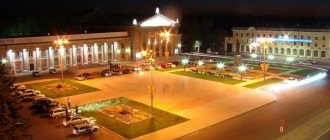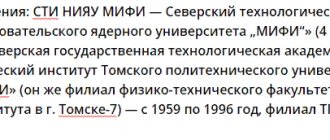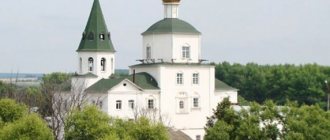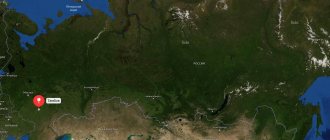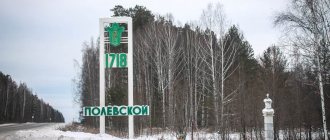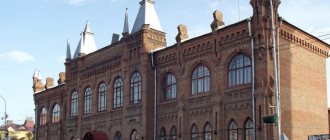Krasnoturinsk is located in the Ural region on the territory of the Sverdlovsk region. It is an important industrial center in the region. It was classified as a single-industry town with a difficult socio-economic situation. The city of Krasnoturinsk appeared in 1944. Its area is 309.5 square kilometers. The population of Krasnoturinsk is 57,514 people.
Geography and history
Initially, the village of Turinskie Rudniki was located on the site of Krasnoturinsk. A. S. Popov, who is the discoverer of radio communications, was born in this locality. Traditionally this was a region of metallurgists. Various types of ore were mined and smelted here.
Krasnoturinsk is located on the eastern slope of the Ural Mountains, 370 km north of Yekaterinburg, near the Turya River. The distance to Moscow is 2079 km.
The climate is relatively continental, with cold, long and snowy winters. The average temperature of the coldest month is -19.7 degrees, and in winter in general -17 degrees. In January, frosts can reach -49 °C. Soil freezing in winter reaches 2 meters.
Summer is warm, with an average temperature of +17 °C. On some days the temperature can rise to +37 degrees. Precipitation varies from year to year from 381 to 668 mm, with an average of 518 mm. The first frosts are observed already in early September. Sometimes they happen even in summer. Real winter comes early - in the last days of October.
The city is surrounded by taiga-type forests consisting of spruce, fir, pine, and larch. Birch, rowan and aspen are also found.
Routes on the map of Krasnoturinsk. Transport infrastructure
From the bus station there are flights to nearby settlements, and there are also long-distance routes to Yekaterinburg, Perm, Tyumen.
Ivdel-Serov highway is a bypass for Krasnoturinsk.
In the vicinity of the city there are railway lines connecting the regional center and Boksity, as well as Karpinsk and Serov.
The following stations of the Sverdlovsk Railway operate: Krasnoturinsk , Vorontsovka , Krasny Zheleznyak .
Urban transport is represented by buses and minibuses, which account for almost 100% of all passenger traffic within the city and in the suburban area.
The Krasnoturinsky tram is rather a rarity:
- The tram service was opened in 1954.
- To date, this type of transport is not popular.
- There is one route with 3 carriages.
- The tram network is single-track, equipped with two sidings.
- The length of the tracks is 3.5 km. This is the shortest tram network in the country.
City population
The number of residents of Krasnoturinsk remained relatively stable until 1946. However, from the 40s to the 60s it increased approximately 6 times, after which it grew slowly and unsteadily until 1992. In 1939, the population was 9,600 people, in 1967 – 61,000 people, and in 1992 – 67,000 residents.
After 1992, the population of Krasnoturinsk as a whole declined, and in 2022 it amounted to 57,514 people. This corresponds to 295th place among the cities of the Russian Federation. A slight decline was observed in the 90s and a more significant one in the 2000s, starting in 2005. This decline was moderate, but continued continuously, year after year.
History of Krasnoturinsk
In mid-autumn 1758, construction began on the banks of the Turya River - the first copper mine, called Vasilyevsky . The owner of the mine and the initiator of the construction was the merchant Maxim Pokhodyashin . Later, at his direction, 4 more mines would be built here - Nikolaevsky , Pershinsky , Sukhodoysky , Frolovsky . They, together with the Vasilyevsky mine and the mining village, formed the first settlement, receiving the name Turinsky mines .
For the next 30 years, the settlement lived by mining iron ore (since 1800) and gold (since 1823). In 1833, a narrow-gauge railway was built the Bogoslovsky plant (now Karpinsk the city of Serov (then it was called Nadezhdinsk ).
The first narrow gauge railway. Photo source: vsenaural.ru
Bogoslovsky Aluminum Plant and the Germans
A new round in the life of the city began in 1931, when bauxite deposits were discovered. At the end of the autumn of 1940, construction began again on the banks of the Turya River - this time the Bogoslovsky Aluminum Plant ( BAZ ) was being built. Upon completion of construction work, the plant became famous as one of the best producers of primary aluminum in Russia ; its products were known outside the country, including in Europe and the USA .
Bogoslovskaya CHPP. Photo source: vsenaural.ru
However, like many other “socialist construction projects” , the BAZ has the other side of the coin - prisoners of the NKVD “correctional” institution were sent here. Mostly dispossessed peasants and ethnic Germans from the Volga region . The mortality rate at the industrial construction site was monstrous - according to minimal estimates, out of 15 thousand German labor army soldiers, about 20% died. “There was no specific guilt behind us, except for our nationality and the fact that we spoke the language of the enemy” - these words, once written down by one of the Labor Army soldiers, are immortalized in the Krasnoturinsk Museum . Also, in memory of those times, a monument to the ethnic Germans who died at the construction site was erected on the shore of the reservoir.
Embankment of the city pond. Photo by: Egor Kharlamov
Surprisingly, some of the former Labor Army members decided to stay in the city, instead of returning to their homeland in the 90s, as most of their compatriots did. Today, 10% of Krasnoturinsk are Germans. By the way, the longest term as mayor of the city was held by a German - Victor Michel , who held this post for 19 years in a row. In terms of national composition Krasnoturinsk is generally a rather diverse city: Russians, Ukrainians, and Belarusians make up about 80% of the townspeople, Bashkirs and Tatars make up 10%, and the rest are Germans. It is not surprising that there is a wide variety of religious communities: there are Orthodox, Protestant, Catholic and Muslim communities.
Little Leningrad
Central square.
Photo source: www.moypolk.ru During the war, Leningrad architects designed the architectural ensemble of Krasnoturinsk , which today distinguishes it from typical Ural towns . For the resulting appearance in the Empire style, the city received a second name - “little Leningrad” . The similarity with the cultural capital of Krasnoturinsk is most evident in the Central Square - it has a semicircular shape and arched buildings are located along its perimeter, which gives it a resemblance to Palace Square in St. Petersburg .
Krasnoturinsk - why not Popovsk?
Author of the photo: novichok2015
On November 27, 1944, the village of Turinsky Mines received the status of a city and was supposed to receive a new name. However, with the latter everything turned out to be not so simple. The neighboring cities - Serov and Karpinsk - were named after famous people born on this land. The former Turinsky mine was supposed to meet the same fate - it was supposed to name the city in honor of the Russian inventor Popov - Popovsky . However, the authorities pursuing a policy of atheism, fearing being misunderstood, rejected this option. I also didn’t want to keep the previous name. Then the adjective “red” was added of the Turya River of Krasnoturinsk .
Vacancies at the employment center of Krasnoturinsk
The list of vacancies published at the end of June 2022 shows a large number of available jobs. The city requires workers in a variety of specialties. There are quite a few engineering vacancies. Salaries there range from 20 to 30 thousand rubles. In other jobs, the amount of payments most often ranges from 13,500 to 20,000 rubles. The highest paid ones reach 37,000 rubles. Obviously, it is not easy to get a job with them.
The minimum salary level is 7475 rubles. - from a speech therapist teacher. The most unusual position is that of a piano tuner (salary 13,500 rubles).
Those who want to work as a dentist can count on a salary of 25,000 rubles, which is quite a bit for this profession.
As in other cities, in Krasnoturinsk you can get a job on a rotational basis. Salaries there are higher: from 68 to 172 thousand rubles. It's either the north or Siberia.
As a result, we can conclude that there should be no problems with employment in Krasnoturinsk.
Sights of the city of Krasnoturinsk
Krasnoturinsk has a fairly developed network of cultural and entertainment institutions. Residents and guests of the city are invited to the Puppet Theater, exhibition hall, cinema, and Palaces of Culture.
A map of Krasnoturinsk with houses will help you study in more detail the locations of the main attractions.
Lovers of city walks will be attracted by the interesting architecture of Central Square , which is also called “little Petersburg”. On the cozy Mira Boulevard, going down to the river, there is a war memorial.
The attractions of Krasnoturinsk are its museums:
- Memorial Museum of A.S. Popov - founded in the house where the inventor of the radio lived as a child. The exhibition introduces the various stages of his life. The house-museum is part of the Krasnoturinsk Local History Museum.
- The Geological and Mineralogical Museum named after Fedorov is another branch of the local history museum. Known for its richest collection of minerals and ores. The memorial office of the founder of the museum, the outstanding geologist Evgraf Fedorov, is open to visitors.
- The local history museum also has a historical exhibition. Excursions and series of lectures are devoted to the history of Krasnoturinsk, outstanding fellow countrymen, and the animal world of the North Ural region.
- The exhibition hall invites you to exhibitions of art works from other cities of the country and introduces the work of local artists. Particularly valuable are the collections of jewelry presented here by Ural masters, Nizhny Tagil trays, and Kasli castings.
Economy and industry of Krasnoturinsk
The main industries of Krasnoturinsk are mining and metallurgy:
- The Bogoslovsky aluminum plant is the main enterprise of the city. BAZ is the leader in the production of alumina in the country, the raw material for it is bauxite from the local Severouralsk deposit;
- Bogoslovskoye Mining Administration – works at deposits of complex magnetite ores (containing copper, iron, cobalt, silver);
- Bogoslovskaya CHPP - supplies electricity and heat to Krasnoturinsk and the aluminum plant;
- gold, silver and platinum are mined;
The city's trading enterprises are represented by local and federal chains - Pyaterochka, Magnit, Euroset, Megafon, MTS.
Main streets of Krasnoturinsk
There are 158 streets in Krasnoturinsk, among the main ones it is worth noting the following:
- Oktyabrskaya is an important transport route of the city. Extends from Karl Marx Street to Komsomolskaya Street. On Oktyabrskaya there is a bus station, the Geological Museum, the New Cinema cinema, religious sites - the Cathedral of Maxim the Confessor, the Alexander Nevsky Chapel, and the Nur Mosque.
- Lenina is the main street of the city, adjacent to the Central Square and Boulevard of Peace. Intersected by Metallurgov, Frunze, Karpinsky, Leninsky Komsomol streets. Here are the Puppet Theater, a branch of the Ural Federal University, the Krasnoturinsky Medical Center, a clothing market and numerous trade enterprises.
- Popova - stretches parallel to Oktyabrskaya Street, intersected by Karl Marx, Karpinsky and Frunze streets. The only city tram line runs here, the Popov Museum, Tikhomirovsky Park, a dental clinic, and the Northern Psychiatric Hospital are located.
A map of Krasnoturinsk with streets will give a more detailed idea of the structure of the city.
